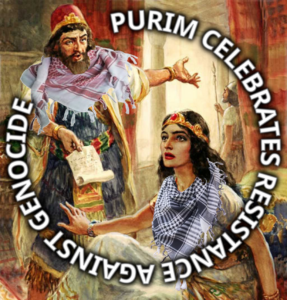(Gershop Pesach Teitelbaum, 14 Adar 5785)

Purim is a festival of resistance. It commemorates the struggle of an oppressed people against the genocidal plans of an occupying colonial regime. It is the story of a people who, under the shadow of empire, organized, fought back, and ensured their survival against the forces of annihilation.
It is a mistake to read Purim as a mere celebration of survival, as if history moves forward without the actions of those who resist. The Megillah itself tells us otherwise: Esther risks her life by revealing her identity, Mordechai refuses to bow to a tyrant, and the Jewish people, rather than waiting for imperial mercy, take matters into their own hands.
But what happens when the lessons of Purim are twisted? What happens when those who were oppressed become the oppressors?
HAMAN IN SHUSHAN, HAMAN IN TEL AVIV
Zionism, which so often imagines itself in the role of Esther or Mordechai, is, in reality, the Haman of today. Like the Persian vizier who sought to exterminate a people because they refused to bow to the empire, the Zionist regime seeks to erase, subjugate, and dispossess the indigenous people of Palestine. Today, as Palestinians face massacres, sieges, and brutal military occupation, Purim demands of us not revelry but resistance.
The Baal Shem Tov taught that everything in the world contains a spark of holiness, even in exile. But exile is not merely a geographical condition; it is also moral. The worst exile is when the people forget who they are, when they become what they once resisted. The Lubavitcher Rebbe once said that Amalek is not just a nation but a force in the world—the force that seeks to destroy the dignity and divine image of the oppressed.
Who is Amalek today? Who is the Haman of our time?
Is it the child throwing stones at the tank, or the one commanding the tank to crush his home?
Is it the woman waiting at a checkpoint for hours, or the soldier denying her passage?
Is it the refugee, or the one who makes him a refugee?
The Zionist state, armed with nuclear weapons and backed by the strongest imperialist forces on earth, claims to be the vulnerable Esther, the righteous Mordechai. But in truth, it is the empire. It is the force of oppression, the one issuing decrees of destruction, forcing an entire people into ghettos, demolishing homes, and committing unspeakable massacres.
PURIM: A FESTIVAL OF ANTI-COLONIAL STRUGGLE
The story of Purim is not about ethnic vengeance; it is about liberation. It is a story of how power can be subverted, how an empire’s own decrees can be turned against it. In the Talmud (Megillah 12a), the sages debate why the Jewish people deserved Haman’s decree in the first place. One answer given is that they had become too comfortable with the rule of Ahasuerus, that they forgot their struggle.
Today, Zionism is a doctrine that teaches Jews to trust in empire, to align themselves with power rather than challenge it. It is a distortion of everything Purim teaches us.
Just as Mordechai refused to bow to Haman, so too must we refuse to bow to modern Hamans—those who justify apartheid, who enforce occupation, who massacre in the name of false security.
To celebrate Purim authentically today is to stand with the oppressed, not the oppressor.
FROM SHUSHAN TO GAZA: THE STRUGGLE CONTINUES
A Chassidic tale is told about Reb Levi Yitzchak of Berditchev. One Purim, he saw a man in rags, sitting alone, drinking from a broken cup. Reb Levi Yitzchak approached him and said, “Brother, why do you not rejoice with us?” The man replied, “Rebbe, how can I rejoice when my people are still in exile?” The Rebbe wept and said, “You are wiser than us all.”
Purim is not a time for empty celebration. It is a time to remember that no empire lasts forever. The lesson of Esther and Mordechai is not to align with imperial power but to subvert it, to use every means available to undermine its oppressive rule.
On Purim, we do not feast in forgetfulness. We celebrate in defiance. We remember the martyrs, the resistance fighters, the revolutionaries, the people who, like those in the story of Purim, refuse to bow. We celebrate those who organize, those who speak out, those who struggle for a world free from empire and oppression.
